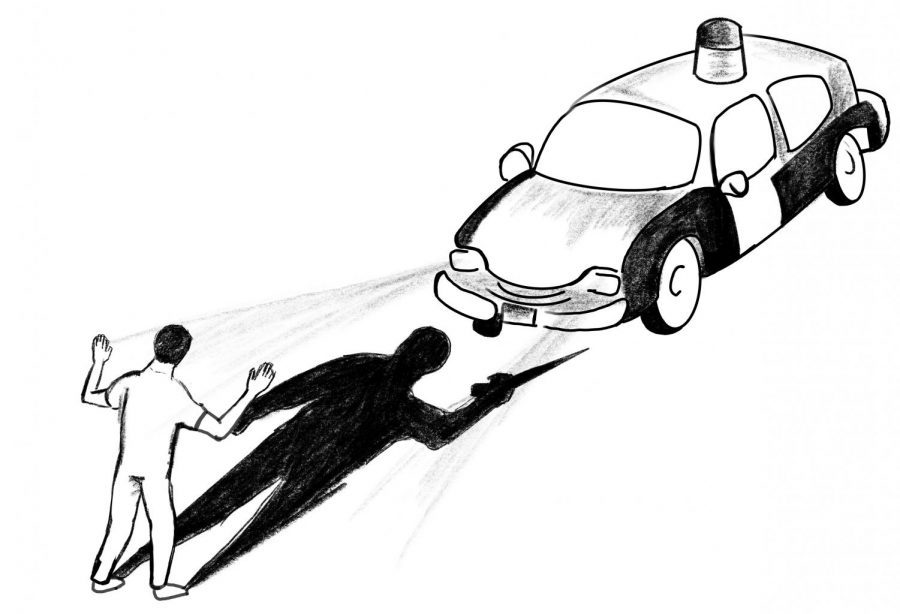Press and police fail to address mental health episodes
In 2018, 25% of the approximately 1,000 people fatally shot by police in the U.S. had mental illness. The Crisis Intervention Team (CIT), a structure in law enforcement designed to minimize accounts of injury or death in encounters between police and people with mental illness, failed to reduce the use of force.
March 6, 2021
Two days before New Year’s Day, 19-year-old Christian Hall stood on a highway overpass in Pennsylvania. He had contacted the police, hoping that they could offer him assistance in the middle of a mental health crisis. However, “objective reasonableness,” a subjective standard that allowed the police to determine whether he posed enough of a threat to justify deadly violence, won over. Pennsylvania State Police decided he did, even releasing a statement claiming that “Hall pointed [a] firearm in the Troopers direction. As a result, Troopers fired striking Hall.”
In the footage of his shooting released in early February, he crumpled with his hands in the air.
Two days before Christmas, Angelo Quinto, a Navy veteran who suffered from depression, was experiencing a mental health crisis when his sister called the police for assistance. When his mother began filming the situation (police officers switched off their body cameras), Quinto is lying face down on the floor.
“What happened,” his mother asks, “What happened?”
No one responds. Quinto died three days later, 65 miles northeast of the upper school campus. His family reported that officers knelt on his back for five minutes, similar to the killing of George Floyd last summer.
A statement from the Antioch Police Department promised “to provide the public with more information” “once some additional portions of the investigation are completed,” although the department waited a month to confirm his death, and only responded after requests from the East Bay Times.
Weeks of chilling silence passed before the deaths of these two men were acknowledged. In Quinto’s case, his killing was only acknowledged due to the family filing a claim against the Antioch Police Department. At a minimum, their stories should be known. They provide deadly examples of unreasonable uses of force in officer intervention.
The lack of coverage and extreme delay in reporting on their deaths expose the gaps in proper police responses to mental health. News articles about Hall quickly end before even two pages of search results, and all but one waited until footage of his shooting was released in February to report on his death. While the police immediately responded with a fatal show of force, the press barely murmured.
Their deaths came as a result of the failure to follow protocol and de-escalate the mental health episode. In 2018, 25% of the approximately 1,000 people fatally shot by police in the U.S. had mental illness. The Crisis Intervention Team (CIT), a structure in law enforcement designed to minimize accounts of injury or death in encounters between police and people with mental illness, failed to reduce the use of force. In 2015, American law enforcement agencies traveled to Scotland to investigate how the country’s officers respond to confrontations. Even in cases involving an armed individual, they responded through methods of crisis intervention rather than immediate force. Bringing in specially trained mental health response teams, requiring body cameras that are open at all times, and eliminating knee-to-neck restraints would center humanity at the forefront of law enforcement.
Establishing partnerships with mental health providers can inform law enforcement on the best practices for responding to mental illness, a condition not bound by age. In 2016, 7.7 million people in the U.S. aged 6 to 17 experienced a mental health disorder, negatively affecting academic performance and overall well-being. However, nearly 80% did not receive proper services, and the pandemic has only increased feelings of loneliness and anxiety. Such instances require responses from trained counselors and not armed officers.
Alternatives to requiring police officers to become trained experts on mental health curricula include diverting 911 police calls to crisis telephone lines staffed with medical professionals who provide guidance to the individual in crisis. Emergency Medical Services can also send Emergency Medical Technicians, counselors, and physicians to bring individuals to specialized facilities for mental health treatment.
Minimizing police response in cases of mental illness both reduces requirements for officers and lowers the chance of fatal uses of force, finally achieving what should be the goal of policing: safety and security.
If you are thinking about suicide or would like emotional support, contact the National Suicide Prevention Lifeline at 1-800-273-8255 or connect with a trained crisis counselor by texting HOME to 741741. If you are experiencing emotional distress, anxiety, or symptoms relating to depression in response to any disaster, contact the Disaster Distress Helpline at 1-800-985-5990.


















![“[Building nerf blasters] became this outlet of creativity for me that hasn't been matched by anything else. The process [of] making a build complete to your desire is such a painstakingly difficult process, but I've had to learn from [the skills needed from] soldering to proper painting. There's so many different options for everything, if you think about it, it exists. The best part is [that] if it doesn't exist, you can build it yourself," Ishaan Parate said.](https://harkeraquila.com/wp-content/uploads/2022/08/DSC_8149-900x604.jpg)




![“When I came into high school, I was ready to be a follower. But DECA was a game changer for me. It helped me overcome my fear of public speaking, and it's played such a major role in who I've become today. To be able to successfully lead a chapter of 150 students, an officer team and be one of the upperclassmen I once really admired is something I'm [really] proud of,” Anvitha Tummala ('21) said.](https://harkeraquila.com/wp-content/uploads/2021/07/Screen-Shot-2021-07-25-at-9.50.05-AM-900x594.png)







![“I think getting up in the morning and having a sense of purpose [is exciting]. I think without a certain amount of drive, life is kind of obsolete and mundane, and I think having that every single day is what makes each day unique and kind of makes life exciting,” Neymika Jain (12) said.](https://harkeraquila.com/wp-content/uploads/2017/06/Screen-Shot-2017-06-03-at-4.54.16-PM.png)








![“My slogan is ‘slow feet, don’t eat, and I’m hungry.’ You need to run fast to get where you are–you aren't going to get those championships if you aren't fast,” Angel Cervantes (12) said. “I want to do well in school on my tests and in track and win championships for my team. I live by that, [and] I can do that anywhere: in the classroom or on the field.”](https://harkeraquila.com/wp-content/uploads/2018/06/DSC5146-900x601.jpg)
![“[Volleyball has] taught me how to fall correctly, and another thing it taught is that you don’t have to be the best at something to be good at it. If you just hit the ball in a smart way, then it still scores points and you’re good at it. You could be a background player and still make a much bigger impact on the team than you would think,” Anya Gert (’20) said.](https://harkeraquila.com/wp-content/uploads/2020/06/AnnaGert_JinTuan_HoHPhotoEdited-600x900.jpeg)

![“I'm not nearly there yet, but [my confidence has] definitely been getting better since I was pretty shy and timid coming into Harker my freshman year. I know that there's a lot of people that are really confident in what they do, and I really admire them. Everyone's so driven and that has really pushed me to kind of try to find my own place in high school and be more confident,” Alyssa Huang (’20) said.](https://harkeraquila.com/wp-content/uploads/2020/06/AlyssaHuang_EmilyChen_HoHPhoto-900x749.jpeg)








